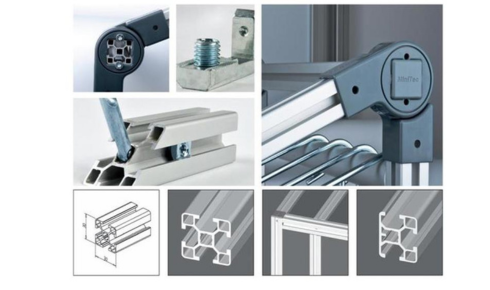Imagine product development as building with blocks—quick, easy, and surprisingly flexible. Now, picture these blocks made from aluminum, neatly fitting together to craft precise prototypes and complex systems without headaches or delays. That’s exactly how MiniTec aluminum framing material simplifies the journey from initial idea to finished product.
Expedited Concept-to-Assembly via Profile-Based Fabrication
MiniTec aluminum framing provides designers with a fast, user-friendly solution for turning sketches into tangible products. Unlike traditional methods that require extensive machining or welding, these kits come pre-cut, ready for immediate assembly. Engineers can swiftly move from a rough idea to a workable prototype in hours instead of weeks.
Because the MiniTec extruded aluminum framing system uses standardized profiles, modifications are effortless. Teams no longer wait days or weeks for custom parts, meaning changes during development can happen on-the-fly. This rapid fabrication approach greatly reduces downtime, keeping creativity flowing and projects moving swiftly forward.
Modular Interchangeability Accelerates Design Iterations
Changing product designs mid-process usually brings stress, but MiniTec aluminum framing makes iteration a breeze. The modular nature of these frames allows parts to snap together or apart quickly, helping teams test multiple versions without starting over each time. Developers gain flexibility to adjust features, tweak dimensions, or even entirely reshape their design without expensive setbacks.
The interchangeability doesn’t just make experimentation quicker—it encourages more adventurous design thinking. Teams can confidently experiment with bold ideas because mistakes are reversible, and changes are nearly instant. Faster iteration cycles mean companies can innovate quicker, capturing market opportunities ahead of their competitors.
Lean Manufacturing Benefits with Reusable Frame Configurations
Lean manufacturing isn’t just about reducing waste—it’s about using resources smarter. MiniTec aluminum framing kits excel in this area by allowing companies to reuse frame components repeatedly across different projects. Instead of disposing custom-built assemblies after each product run, the modular profiles can be reconfigured into entirely new setups, significantly cutting down on material costs and waste.
This recyclable approach brings efficiency and flexibility to production floors. Companies can swiftly transition from producing one product to another using the same inventory of components, dramatically reducing downtime between production cycles. Less waste, fewer costs, and more adaptable production processes become achievable goals rather than distant ideals.
Enhanced Cross-Functional Collaboration through Accessible Design
Great products usually emerge from teamwork, but collaboration often gets messy when design methods are too complicated. MiniTec extruded aluminum framing simplifies the complexity, making the product development process understandable for anyone on the team—from seasoned engineers to marketing specialists. With intuitive connections and easy-to-follow assembly methods, all team members can easily share ideas and directly contribute to building the prototype.
This inclusive design style improves communication across departments, ensuring everyone feels involved and understands the product vision. Engineers, sales staff, and even production workers can quickly adjust frames or suggest improvements, streamlining the entire development process and strengthening teamwork from beginning to end.
Shortened Validation Periods with Rapid Reconfiguration
Testing and validation typically involve slow adjustments, especially if tools or fixtures require significant rework. MiniTec aluminum frame kits solve this problem with their quick-adjust nature. Components can be rapidly reconfigured on-site to test different scenarios, evaluate design strengths, or identify weaknesses in real-time without halting production for extensive retooling.
Shorter validation cycles mean quicker market readiness. Businesses can more rapidly confirm their products meet quality standards and regulatory compliance, ensuring faster delivery to customers. The agility offered by these kits reduces risks associated with long validation periods and boosts overall confidence in product reliability and performance.
Efficient Integration of Complex Components and Assemblies
Building complex products often feels like putting together a puzzle with mismatched pieces. Fortunately, MiniTec aluminum framing material excels at making complex integrations straightforward. It provides sturdy yet flexible foundations for mounting automation equipment, conveyors, or precision measurement tools with remarkable ease.
Engineers benefit immensely from the adaptability of these frames. Complex sensors, actuators, or robotic arms seamlessly integrate without custom-made brackets or fixtures, significantly accelerating the assembly of sophisticated systems. This efficiency not only reduces assembly time but enhances overall reliability by ensuring precise alignment and stable operation of integrated components.
Cost Reduction Achieved by Eliminating Custom Tooling
One of the hidden expenses in manufacturing arises from custom tooling. Specialized machining processes and dedicated tools add considerable costs and delay project timelines. MiniTec aluminum framing effectively eliminates this problem since its standardized modular design requires no specialized tools or machinery for assembly.
The cost savings extend beyond the initial investment. Without custom tooling, businesses avoid additional costs related to maintenance, repairs, and replacements. They also benefit from reduced lead times since assembly requires only basic hand tools. This affordability enables organizations to manage budgets more effectively, channeling resources into product innovation rather than expensive, single-use equipment.



